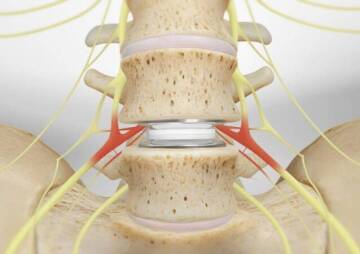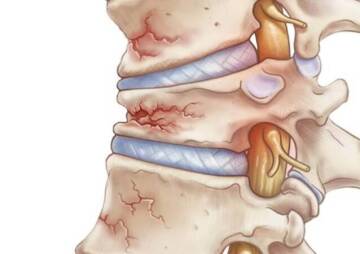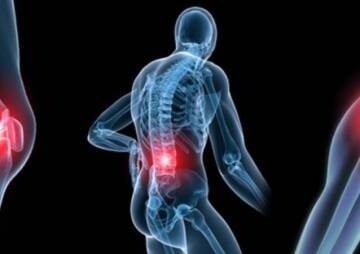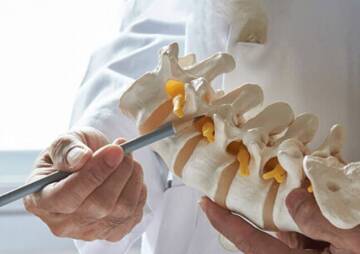-
فئة
Craniomaxillofacial Surgery
Orthopedic Surgery
Spine Surgery
Orthopedic Implants
Hip Surgery
Knee Surgery
Pectus Excavatum
Bone Graft
Disinfectants
Healthcare
Problems with artificial disc replacement

One of the main problems with artificial disc replacement that patients deal with is handling the pain. Like typical orthopedic implants, lumbar disk replacement is a surgery that requires a general hospital stay, typically for a few days, and a series of conservative cares at home for about three months.
One of the main problems with artificial disc replacement that patients deal with is handling the pain. Like typical orthopedic implants, lumbar disk replacement is a surgery that requires a general hospital stay, typically for a few days, and a series of conservative cares at home for about three months. What happens after a lumbar fibrocartilage replacement is important for patients’ rehabilitation.
Moreover, like all surgery involving anesthesia, there are some risks related to artificial disc replacement similar to trauma, nerve injury, infection, sensitivity to the bogus disc's materialsBottom of Form
out of the disc's elements, dislocation of the implant, injury to the vertebra to that the fibrocartilage replacement is applied, failure to enhance following the procedure.
Meanwhile, the general question is whether surgery is your best option or not. In this article, we intend to describe the problems that exist in the way of this surgery and conclude whether it is necessary for people to perform this surgery or not.
Artificial disc replacement
Artificial disc replacement is one of the back or spine surgeries. The spine is created from bones referred to as vertebrae that are stacked on prime of every alternative.
The intervertebral fibrocartilage act as protective shock absorbers that allow the vertebrae to rotate and move without rubbing the bones together. The discs and lumbar vertebrae are located at the end of the spine. Spinal prosthesis surgery means replacing a worn fibrocartilage in the lower part of the spine with a synthetic disc. An artificial disc is made of metal or a combination of metal and plastic. Artificial disc replacement is usually considered as an alternative to more common fusion surgery or vertebrae drying. In the case of fusion surgery, two beads are welded together forever. Spinal prosthesis surgery is a major surgery that requires general anesthesia and hospitalization.
Types of spinal prostheses
An artificial disc, additionally known as a disc replacement, fibrocartilage prosthesis, or spinal arthroplasty device may be a device that's inserted into the spine to supply functions just like regular fibrocartilage functions, corresponding to weight-bearing and movement.
The different forms of artificial fibrocartilage operation will be divided into 2 general categories: total disk replacement and disk core replacement. Within the observation of total disc replacement, because the name implies, all or most of the fibrocartilage tissue is removed and also the artificial fibrocartilage is placed within the intervertebral area. In observe, however, solely the middle of the disc (nucleus or nucleus) is removed associated replaced with an implant. The external part of the disc (annulus) isn't removed.
Who needs an artificial disc replacement?
The indications for disc replacement might vary for every kind of implant. Some general indications are pain arising from the fibrocartilage that has not been adequately reduced with non-operative care comparable to medication, injections, chiropractic care, or therapy. Generally, you may have had a magnetic resonance imaging that shows fibrocartilage degeneration. Typically discography is performed to verify that fibrocartilage, if any, are concerning your pain. The surgeon can correlate the results of those tests with findings from your history and physical examination to assist confirms the supply of your pain.
There are many problems with artificial disc replacement that will forestall you from receiving a disc replacement. These embrace spondylolisthesis, osteoporosis, and vertebral body fracture, allergy to the materials in the device, spinal tumor, spinal infection, and morbid obesity, significant changes of the facet joints, pregnancy, chronic steroid use or autoimmune problems. In the meantime, total disc replacements are designed to be planted from Associate in the nursing anterior approach. You will be excluded from receiving and artificial disc if you antecedently had abdominal surgery or if the condition of the blood vessels ahead of your spine will increase the danger of great injury throughout this kind of spinal surgery.
To treat this case, alternatives to fibrocartilage replacement embrace fusion, non-operative care, or no treatment. Typically, surgery isn't thought-about for disc-related pain unless the pain has been severe for a protracted amount, and also the patient has had non-operative treatments.
Problems with artificial disc replacement
There are problems with artificial disc replacement and these problems can stop spinal restorative surgery. These embrace spondylolisthesis, osteoporosis, hypersensitivity to the materials employed in prosthetics, spinal tumors, spinal infections, severe blubber, vital changes within the quick joints, pregnancy, long-run steroid use, or autoimmune issues. General fibrocartilage replacement surgery is additionally performed from the front. In addition, prosthesis surgery won't be performed if the patient contains a history of abdominal surgery or if the condition of the arteries within the front of the spine will increase the chance of significant injury throughout this sort of surgery.
Low back pain is usually the result of Associate in Nursing injury or erosion of the fibrocartilage. Various therapies that are suggested for the treatment of this complication embrace fusion surgery or drying of the vertebrae, non-surgical treatment, or patient direction. Surgery isn't sometimes suggested to alleviate disc pain unless the pain persists for over six months and also the patient has non-surgical treatments comparable to active physiotherapy, medication, injections, adjustment of activity, or manual manipulation and spinal therapy.
Risks of spinal prosthesis surgery
Spinal prosthesis surgery, like any other operation, has its own risks. Surgeons in spinal prosthesis surgery need more access than standard lumbar spine fusion surgery, so prosthetic surgery is a more dangerous operation.
Possible problems with artificial disc replacement
- Infection of the artificial disc or surrounding area
- Displacement or detachment of the artificial disk
- Breakage or failure of the prosthesis
- Wear or loosen the prosthesis
- Spinal canal stenosis due to rupture of the vertebrae
- Spinal dryness or stiffness
- Blood clots in the legs due to decreased activity
- If the patient has other complications, there is a risk of further postoperative risks.
Life after lumbar disc replacement
Patients are admitted to the hospital a few days after surgery. Because the lumbar prosthesis does not require bone fusion, the recovery time is shorter than other spinal surgeries.
If necessary, the patient is given painkillers and asked the next day to stand and walk.
The serum and the bladder catheters are also removed a few days after surgery.
The patient is taught the correct way to move and perform exercises such as gentle rotation of the upper body.
Exercise keeps the spine soft and flexible and accelerates the healing and rehabilitation process.
As the healing process progresses, the patient is encouraged to walk and do stretching exercises.
It is forbidden to perform intense and irritating movements or activities for a while.
The recovery period lasts from a few weeks to a few months.
Spinal prosthesis surgery usually relieves pain but does not completely eliminate it.
In order to have a reasonable and realistic expectation of the result of the operation, be sure to consult with your doctor before the operation; Also, ask your doctor for advice on postoperative care and the do's and don'ts of recovery, and to advise you on how to care for the wound, warning signs of the problem, and when
Health News Center spinal implants
In general, there are several factors that can affect the success rate of artificial disc replacement surgery.One of these factors is the implant used in the patient's body. In addition to accurate design, this implant must have the desired quality of construction and raw materials in order to increase the success rate of this surgery. Due to the general problems mentioned above, the use of appropriate and quality implants can solve many of the above problems, along with the expertise and skill of the physician. Therefore, Health News Center has tried to find solutions to meet the health needs of its customers, relying on the latest knowledge in the world and considering the best options.
In this way, relying on the features of Health News Center implants, it is possible to prevent and deal with many of the problems mentioned above. Health News Center has paid attention to the problems mentioned above and has tried to consider and solve the necessary points in the design, production, and supply of orthopedic implants
Health News Center spinal implants are classified into the Rods, vertical screws, and hooks that you can see these products on the website below.
Conclusion
Disc prosthesis surgery is quickly changing into choice in treating patients with symptomatic chronic disc malady. Solely short and midterm results are represented in the literature. In patients, problems may be expected to extend with longer follow-up, the same as total joint replacements within the extremities. Artificial disc replacement surgery may be a comparatively safe procedure but like any other surgery, it`s not without risk. Before a judgment is created concerning surgery, it's recommended to find out concerning the procedure’s risks and potential issues.






